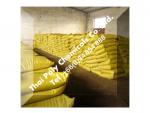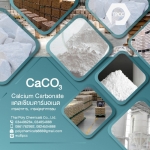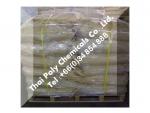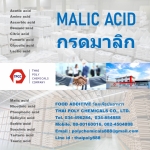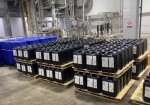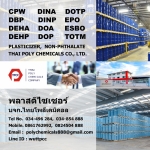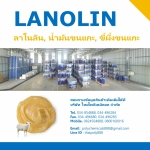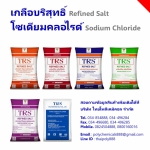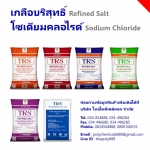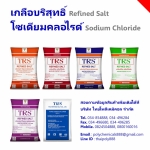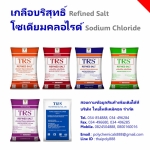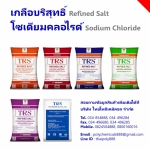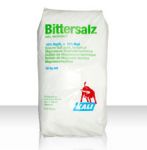แคลเซียมลิกโนซัลโฟเนต, Calcium Lignosulphonate, Calcium Lignosulfonate |
฿1 |
|
ชื่อผู้ประกาศ : อัศวิน เบอร์โทรศัพท์ : 034854888, 034496284 โทรศัพท์มือถือ : 0800160016 ที่อยู่ : 36/5 ม.9 ต.นาดี อ.เมืองสมุทรสาคร ร้าน TPCC |
แคลเซียมลิกโนซัลโฟเนต, แคลเซียมลิกโน, Calcium
Lignosulphonate, Calcium Lignosulfonate, Lignosulphonate, lignosulfonate, ลิกโนซัลโฟเนต,
Calciumligno, Calciumlignosulphonate, Calciumlignosulfonate, ลิกโนซัลโฟเนท,
ลิกโนซัลโฟเนธ
Calcium Lignosulphonate, แคลเซียมลิกโนซัลโฟเนต, แคลเซียมลิกโนซัลโฟเนท
LIGNOTECH, BORRESPERSE
Lignosulfonates, or sulfonated
lignin, (CAS number 8062-15-5) are water-soluble anionic polyelectrolyte polymers: they are byproducts from the production of wood pulp using sulfite
Most delignification in sulfite
pulping involves acidic cleavage of ether bonds, which connect many of the
constituents of ligninUses
Lignosulfonates have a wide
variety of applications.The single largest use for
lignosulfonates is as plasticizers in making concrete,[1] where they allow
concrete to be made with less water (giving stronger concrete) while
maintaining the ability of the concrete to flow. Lignosulfonates are also used
during the production of cement, where they act as grinding aids in the cement
mill and as a rawmix slurry deflocculant (that reduces the viscosity of the
slurry).Lignosulfonates are also used for
the production of plasterboard to reduce the amount of water required to make
the stucco flow and form the layer between two sheets of paper. The reduction
in water content allows lower kiln temperatures to dry the plasterboard, saving
energy.The ability of lignosulfonates to
reduce the viscosity of mineral slurries is used to advantage in oil drilling
mud, where it replaced tannic acids from quebracho (a tropical tree).Lignosulfonates are used to
disperse pesticides, dyes, carbon black,[6] and other insoluble solids and
liquids into water. They are used in tanning leather. They are also used to suppress
dust on unpaved roads.Oxidation of lignosulfonates from
softwood trees produced vanillin (artificial vanilla flavor).Dimethyl sulfide and dimethyl
sulfoxide (an important organic solvent) are produced from lignosulfonates. The
first step involves heating lignosulfonates with sulfides or elemental sulfur
to produce dimethyl sulfide. The methyl groups come from methyl ethers present
in the lignin. Oxidation of dimethyl sulfide with nitrogen dioxide produces dimethyl
sulfoxide (DMSO).Also one of the very wide uses of
lignosulfonates is deflocculation of clays used in drilling fluids in the oil
and gas industry.Calcium Lignosulphonate,
Dispersant for wettable powders, dry flowables and extruded water dispersible
granules. Binder for granules and seed coatingsDescription:
Calcium Lignosulphonate is a
anionic surfactant. It is a water-reducing agent in concrete construction,and
an excellent adhesive in refinery application.Main application:
1 water-reducing agent
a. prefabricated or fresh concrete
construction.b. preparation of antifreezing,
pump-deliverable water reducing agent.c. preparation of different type
of water reducing agent.2 adhesive
a. It is used as mineral powder
adhesive to improve recovery rate in refinery process.b. It is an excellent adhesive for
fireproof products. It can improve the products' strength and prevent cracks.c. It reduces the viscosity of
clay and improves the product yields in the ceramic fabrication.d. If is added with phenol type
additives in electrolysis, purer precipitates is formed.The Panel on Food Additives and
Nutrient Sources added to Food provides a scientific opinion on the safety of calcium lignosulphonate (40-65) when used as a carrier for vitamins and carotenoids intended to be added to foods for colouring and nutrient purposes. Calcium lignosulphonate (40-65) has been evaluated by JECFA and an ADI of 20 mg/kg bw/day was established. Calcium lignosulphonate (40-65) is poorly absorbed following oral administration. From the results obtained in vitro from one bacterial reverse mutation assay and one mammalian chromosomal aberration assay it can be concluded that there is no indication for a genotoxic potential of calcium lignosulphonate (40-65). In a short-term 28-day toxicity study, a NOAEL of 1500 mg/kg bw/day was identified for calcium lignosulphonate (40-65) based on minimal focal/multifocal chronic inflammation in the rectum of male rats. In a 90-day subchronic toxicity study the petitioner identified a NOAEL of 2000 mg/kg bw/day for calcium lignosulphonate (40-65), the highest dose tested. The Panel, however, considered this study inadequate for evaluating the safety of calcium lignosulphonate (40-65) due to the high incidence of lymphoid hyperplasia and lymphoid infiltration in the mandibular and mesenteric lymph nodes, in the Peyer?s patches and in the liver in all animals, including controls. Therefore, the Panel considers that available data on calcium lignosulphonate (40-65) are insufficient to establish an ADI. Furthermore, the Panel considers that long-term toxicity studies are needed to elucidate whether the histiocytosis in the mesenteric lymph nodes of the rats observed in the inadequate 90-day toxicity study may progress into a more adverse state with time. Overall, based on the available information, the Panel concludes that the safety of use of calcium lignosulphonate (40-65), as a carrier for vitamins and carotenoids intended to be added to foods for colouring and nutrient purposes,
? European Food Safety Authority,
2010Summary
Following a request from the
European Commission, the Panel on Food Additives and Nutrient Sources added to
Food (ANS) was asked to deliver a scientific opinion on the safety of calcium
lignosulphonate (40-65) when used as a carrier for vitamins and carotenoids
intended to be added to foods for colouring and nutrient purposes. According to the petitioner, the proposed
name of calcium lignosulphonate (40-65) distinguishes the product from other
available calcium lignosulphonates presenting lower degrees of lignin
polymerisation and higher content of sugars. Lignosulphonates are used in a
variety of food manufacturing applications including dispensing, binding,
complexing and emulsifying. Calcium lignosulphonate (40-65) is an amorphous
yellow-brown to brown polymer derived from lignin, not having a well defined
structural or molecular formula, with an average molecular weight between 40000
and 65000 g/mol. In vitro and in vivo assays have shown that calcium
lignosulphonate (40-65) is poorly absorbed by the oral route.Calcium lignosulphonate (40-65)
has been tested in in vitro genotoxicity, short-term, subchronic and
developmental toxicity studies in accordance with recognised guidelines. No
long-term or carcinogenicity studies were conducted with calcium
lignosulphonate (40-65).From the results obtained in vitro
from one bacterial reverse mutation assay and one mammalian chromosomal
aberration assay it can be concluded that there is no indication for a
genotoxic potentialof calcium lignosulphonate (40-65). The Panel noted that a
test for induction of gene mutations in mammalian cells in vitro, as
recommended by the Guidance on submissions for food additive evaluations (SCF,
2001), has not been performed. The petitioner considered that such an assay was
unnecessary since, given its high molecular weight, calcium lignosulphonate
(40-65) is unlikely to enter the cells. The Panel agreed with this argument. In
a short-term 28-day toxicity study a No Observed Adverse Effect Level (NOAEL)
of 1500 mg/kg bw/day was identified for calcium lignosulphonate (40-65) based
on minimal focal/multifocal chronic inflammation in the rectum of male rats. In
a 90-day subchronic toxicity study, the petitioner identified a NOAEL of 2000
mg/kg bw/day for calcium lignosulphonate (40-65), the highest dose tested. The
Panel, however, considers this study inadequate for evaluating the safety of
calcium lignosulphonate (40-65) due to the high incidence of lymphoid
hyperplasia and lymphoid infiltration in the mandibular and mesenteric lymph
nodes, in the Peyer?s patches and in the liver in all animals, including
controls.In a developmental toxicity study
(21 days) in the rat, no treatment-related effects in dams or fetuses were
reported up to the highest dose tested and a NOAEL of 1000 mg/kg bw/day can be
identified for calcium lignosulphonate (40-65) from this study.Exposure estimates were based on
the reported European high percentile intakes of vitamins from food and
Tolerable Upper Intake Levels (ULs) of vitamins for children and adults, and on
the percentage of calcium lignosulphonate (40-65) proposed by the petitioner to
be used as a carrier. The maximum intake of calcium lignosulphonate (40-65)
resulting from its use as a carrier for vitamin A cannot be estimated for
children under 10 years old and adults, as the food intake of this vitamin is
higher than the UL. The maximum intake of calcium lignosulphonate (40-65)
resulting from its use as a carrier for vitamin A varies between approximately
500 and 3700 ?g/day for children aged 11-17 years. The maximum intake of
calcium lignosulphonate (40-65) resulting from its use as a carrier for vitamin
D ranges from approximately 2100 to 8000 ?g/day for children under 18 years old
and it is approximately 6500 ?g/day for adults. The maximum intake of calcium
lignosulphonate (40-65) resulting from its use as a carrier for vitamin E
ranges from 88.8 to 224.3 mg/day for children under 18 years old and is 264
mg/day for adults. The maximum intake of calcium lignosulphonate (40-65)
resulting from its use as a carrier for vitamin K is less than 200 mg/day.The maximum intake of calcium
lignosulphonate (40-65) resulting from its use as a carrier for multivitamins
(vitamins A, D, E and K) ranges from 366.9 to 410.4 mg/day for children aged 11
to 17 years, ranges from 278.7 to 318.7 mg/day for children aged 3-10 years, is
265.3 mg/day for children under 3 years old, and is 439.3 mg/day for adults.Exposure estimates of calcium
lignosulphonate (40-65), resulting from its use as carrier for carotenoids as
proposed by the petitioner, were based on the estimated intake of carotenoids
from natural sources, food additives and food supplements. The estimated
intakes of calcium lignosulphonate (40-65), resulting from its use as a
carrier, ranges from less than 10 to over 100 mg/day for b-carotene and
zeaxanthin, from less than 10 to 95 mg/day for lutein and from less than 10 to
125 mg/day for lycopene. No estimates have been made for intake of calcium
lignosulphonate (40-65) resulting from its use as a carrier for canthaxanthin
(food colour limited to saucisses de Strasbourg) and b-apo-8?carotenal (no
intake data available and no uses as food supplement) as their intakes are
likely to be low. The Panel cannot provide a more refined exposure assessment
for calcium lignosulphonate (40-65) resulting from its use as carrier for these
colours since these colours are still under evaluation in Europe and their
intakes have not yet been evaluated.The Panel considers that the available data on
calcium lignosulphonate (40-65) were insufficient to establish an ADI.The Panel
further considers that the 90-day study with a 4-week recovery period is
inadequate for the evaluation of the safety of calcium lignosulphonate (40-65).
Therefore, the Panel considers that long-term toxicity studies are needed to
elucidate whether the histiocytosis in the mesenteric lymph nodes of the rats
observed in the inadequate 90-day toxicity study may progress into a more
adverse state with time.Overall, based on the available
information, the Panel concludes that the safety of use of calcium
lignosulphonate (40-65), as a carrier for vitamins and carotenoids intended to
be added to foods for colouring and nutrient purposes, cannot be assessed.Keywords
Calcium lignosulphonate (40-65),
CAS No. 8061-52-7, lignosulphonic acid calcium salt, calcium lignosulphate,
lignin calcium sulphonate, carrier, vitamins and carotenoids
สอบถามข้อมูลเพิ่มเติมได้ที่
ฝ่ายขาย
Thai
Poly Chemicals Co., Ltd.
บริษัท
ไทยโพลีเคมิคอล จำกัด
ที่อยู่36/5
ม.9 แขวง/ตำบลนาดี เขต/อำเภอเมืองสมุทรสาคร จังหวัดสมุทรสาคร รหัสไปรษณีย์74000
Tel.:
034854888, 034496284
Fax.:
034854899, 034496285
Mobile:
0824504888, 0800160016
Website
: www.thaipolychemicals.com
Email1 : thaipolychemicals@hotmail.com
Email2 : info@thaipolychemicals.com
LignosulfonatecalciumลิกโนซัลโฟเนทลิกโนซัลโฟเนตcalciumlignosulfonatlignosulfonatelignosulphonatelignoLignosulphonateแคลเซียมลิกโนซัลโฟเน

